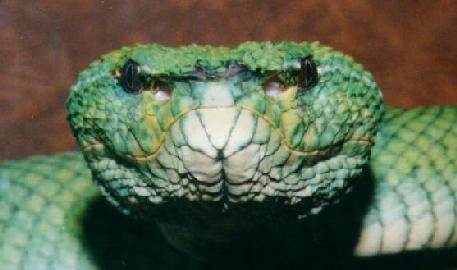


Natural History of the
Wagler's Viper
Tropidolaemus wagleri
By Scott Lacina
| Tropidolaemus wagleri (common
names: Wager's and Temple Viper). Formerly included in the Trimeresurus Genus, it
has been placed in its single species Genus due to unique qualities found in scale and
venom. T. Wagleri was first described by Boie in 1827 and named after the 19th
century German naturalist Wagler, from which one of its common names is derived. The
second "Temple Viper" comes from the famous or infamous "Temple of the
Azure Cloud", also known as The Snake Temple, a 150 year old temple located now in a
bustling city on the island of Penang, off of peninsular Malaysia. The vipers are seen as
holy representatives of the deity Chor Soo Kong. Large numbers of wagleri are kept
on plants and statues in and around the temple and are handled freely and freehandedly by
the temple keepers. The snakes are said to have inhabited the temple naturally and are
reported by the keepers not to bite, possibly due to thick clouds of incense burned inside
the temple which is said to calm the already mostly lethargic snakes. Tourists are given
the opportunity to muster up their nerve and pose for their own souvenir photos holding a
handful of the live snakes (fangs removed and heads marked with paint to identify them).
It is thought that the snakes bring good luck, and some of the people in the region
welcome and keep them in their homes.
Photo: At the Snake Temple. (that's not me) Tropidolaemus wagleri are indigenous to parts of Indonesia, Malaysia Philippines, and the Archipelago's (made up of over 20,000 islands near and at the equator). Daytime temperatures in the region average approximately 96 degrees F and nights at approximately 75 degrees F with the dry season taking place from March through May. During the wet season rain can be expected every day. "Phases" of T. wagleri vary within local the snakes and cover a wide array of color combinations and body sizes. Adult females have four distinguishable phases named after geographic regions, with notable variations occurring in each. There is most likely an overlap of phases, and remember they are just phases not sub-species. The Malaysian phase has probably the most recognized, in part due to photos taken at the Snake Temple. Coloration is typically a black background with yellow bars across the back, a yellow belly and a scattering of yellow to green spots in between (1 per scale). The Sulawesi phase has typically a green background with 1/4" to 3/4" blue bars ordered with white across the back and a blue lateral stripe from the nostril through the eye to the angle of the jaw. The belly is cream with blue "water coloring" at the border of the ventral and dorsal scales, and has varying amounts of small blue spots near the edge of the ventrals. The Sulawesi and Kalimantan (which is described next) phases literally look painted with watercolors. The Kalimantan phase is probably the most desired of the phases due to its potential amount of blue coloring, but the colors can range in to almost solid shades of green with a cream belly. The ultimate combination of Kalimantan is a yellow background with pure blue bars (50/50) across the back: Break out the sunglasses! The last phase is referred to as the Philippine or "dwarf" phase. So called because of the unusually disproportionate relation in size to all other phases. Adults retain their juvenile pattern and coloration, and retain a smaller size. An adult female Philippine phase seldom reaches lengths of over 20", while the other phases can surpass lengths of 40".
Photo: Two different Kalimantan phase. As mentioned in the "Operations Manual", male Tropidolaemus wagleri are a whole other story! As juveniles, all phases start as a green bodied snake, cream to green ventral scales, with varying degrees of brick with white colored twin spots running the length of the back and a brick colored line through the eye. As adults, all phases are typically green bodied with varying degrees of brick with white colored twin spots running the length of the back and a brick colored line through the eye. I have heard rumors of adult males obtaining typical adult female coloration at maturity, but have never seen this. One of the most interesting characteristics of T. wagleri can be described in two words, all caps. "SEXUAL DIMORPHISM". Is it the ontogenetic change females exhibit from lime green typically barred juveniles to the heavy bodied adult with colors that include black, yellow, cream, green and blue? Or is it that males start as slender twin spotted juveniles, and with sexual maturity only changing length not proportion? The size difference is almost unbelievable. One species of snake can cover a wide variety of arboreal pit-viper examples.
Tropidolaemus wagleri are usually lethargic animals. In captivity, they sometimes go without noticeable movement for days or even months - the trait of an ambusher. Without rain they become dormant, waiting for the inevitable tropical weather to stimulate animation. They are able to withstand weeks of water scarcity by lying still, yet survival in captivity depends on adequate hydration, and adequate hydration depends on the stimulation that is usually provided by rain. They also appear to be highly territorial, and because of this - extremely dangerous (though only observed by me in captive housing enclosures). Do not enter their strike range while they are on their roost! Interestingly, during manipulation their demeanor totally changes to a placid, apparently curious snake, but as with all venomous snakes: never let your guard down and always work cautiously with them. Although I have heard of no reported human deaths from Tropidolaemus wagleri envenomation, their fangs are very formidable and the venom can subdue mice in mere seconds.
P.S. Anyone with suggestions, noticing missed information, or with other comments: please e-mail me at: dontgetbit@sprintmail.com |
